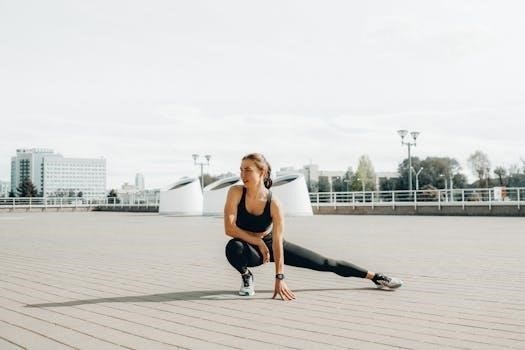Understanding Jumper’s Knee (Patellar Tendonitis)
Jumper’s knee, or patellar tendonitis, involves irritation of the patellar tendon, which is located just beneath your kneecap. This often results from repetitive or excessive overload onto the tendon. Activities that tire the tendon can cause pain.
Definition and Causes of Jumper’s Knee
Jumper’s knee, also known as patellar tendonitis, is a condition characterized by pain and inflammation of the patellar tendon. The patellar tendon connects the kneecap (patella) to the shinbone (tibia). This tendon plays a crucial role in knee extension and absorbing impact during activities. Jumper’s knee typically develops from repetitive or excessive stress on the patellar tendon, such as frequent jumping, running, or squatting.
Activities involving abrupt movements can contribute to this condition. Other factors include reduced quadriceps flexibility, exercising on hard surfaces, improper footwear, and being overweight. It is more common in athletes who participate in sports that involve a lot of jumping, hence the name “jumper’s knee.” Understanding these factors is crucial for both prevention and effective management.
Symptoms of Jumper’s Knee
The primary symptom of jumper’s knee is pain localized to the patellar tendon, just below the kneecap. This pain often starts gradually and worsens with activity, especially jumping or running. Individuals may experience discomfort during or after exercise. Prolonged sitting or standing can also exacerbate the pain. Tenderness to the touch is common when pressing on the patellar tendon.
In some cases, stiffness in the knee may also be present, particularly in the morning or after periods of inactivity. As the condition progresses, the pain may become more constant and interfere with daily activities. Some individuals may experience swelling around the patellar tendon. Recognizing these symptoms early is essential for prompt diagnosis and intervention to prevent chronic issues.

Diagnosis and Treatment
Diagnosis involves a clinical assessment with history taking and a physical exam. Ultrasound is readily available and affordable and can facilitate the diagnosis. The primary treatment focuses on conservative methods.
Diagnosis of Jumper’s Knee
Jumpers knee is typically diagnosed clinically through a detailed history taking and physical examination by a healthcare professional. The process often involves discussing the patient’s symptoms, activity levels, and any recent changes or increases in exercise intensity that may have contributed to the condition. A physical exam usually includes palpating the patellar tendon to identify areas of tenderness or swelling.
Imaging studies, such as ultrasound, can facilitate the diagnosis, especially when the clinical findings are unclear. Ultrasound is readily available, affordable, and able to visualize the patellar tendon, revealing any thickening, inflammation, or structural abnormalities. In some cases, MRI may be used to rule out other potential causes of knee pain or to assess the extent of tendon damage.
It’s essential to consult with a qualified healthcare provider for an accurate diagnosis and appropriate management plan to address the specific needs of each individual case.
Conservative Treatment Methods
Conservative treatment for jumper’s knee primarily revolves around reducing activities that place a loading impact on the knee, allowing the inflamed patellar tendon to heal. Rest is crucial in the initial stages to avoid further irritation and promote recovery.
To alleviate pain and inflammation, ice application for 15-20 minutes several times a day is recommended. Compression using a patellar tendon strap or orthotic taping can help reduce strain across the tendon as activity is gradually resumed. Additionally, pain relief can be achieved through over-the-counter medications or prescription anti-inflammatory drugs.
Once the initial pain subsides, restoration of function is achieved through physical therapy and exercise. A physical therapist can guide patients through targeted exercises to strengthen the knee and reduce further injury, while addressing any underlying biomechanical issues that may contribute to the condition. Avoiding movements and exercises that stress the knee, such as deep squats or high-impact activities, is also essential during the recovery phase.

Effective Exercises for Jumper’s Knee
Exercises play a major role in healing the patellar tendon, promoting strength and flexibility. Stretching is the first step, followed by strengthening, to restore function gradually and effectively.

Stretching Exercises
Stretching exercises are the initial step in a physical therapy program for jumper’s knee. They are crucial for relieving tension and improving flexibility in the muscles surrounding the knee. Static stretches of the quadriceps and hamstrings are particularly beneficial.
To perform a quadriceps stretch, gently pull your foot towards your bottom while standing. If needed, hold onto something for balance. Hold the stretch for at least 30 seconds and repeat three times.
For hamstring stretches, lean forward, keeping your back straight, until you feel a stretch in the back of your thigh. Similarly, hold this position for 30 seconds and repeat.
Regular stretching helps reduce lingering tension that may contribute to knee pain. Always ease into each stretch slowly, and stop if you feel any pain. Consistent stretching improves muscle elasticity.
Strengthening Exercises
Strengthening exercises are essential for healing the patellar tendon in cases of jumper’s knee. These exercises should begin as soon as pain allows and progress slowly over six months or more. Building strength in the surrounding muscles helps support the knee joint and reduces strain on the tendon.
Examples of strengthening exercises include seated quad sets, where you tighten your thigh muscles while sitting with your leg extended. You can also perform side-lying leg lifts to strengthen the hip abductors, which contribute to knee stability.
It’s important to avoid deep squats or lunges initially, as these can stress the knee. Start with low weight and gradually increase the load as your strength improves. Consistency is key.
Isometric Exercises
Isometric exercises are a valuable part of rehabilitation for jumper’s knee, helping to maintain muscle strength during the healing process. These exercises involve contracting a muscle without changing its length or moving the joint. They are particularly useful when pain limits the ability to perform dynamic movements.
A common isometric exercise for jumper’s knee is the quad set. Sit or lie down with your leg straight, tightening your thigh muscles and holding the contraction for several seconds. Another option is to press your foot against a wall, engaging your quadriceps without moving your knee. Typically, hold for 30–45 seconds.
Frequency is key; perform these 2-3 times a day. Adjust frequency based on your pain levels.
Eccentric Exercises
Eccentric exercises are a cornerstone in treating jumper’s knee, focusing on lengthening the muscle while it’s under tension. This type of exercise has been shown to be highly effective in strengthening the patellar tendon and reducing pain.
A common eccentric exercise is the decline squat. Stand on a slightly declined surface and slowly lower yourself into a squat, focusing on controlled movement. It is beneficial to begin with a warm-up exercise that does not involve knee extension. The stretching is a static stretch of quadriceps and hamstrings.
It’s crucial to start slowly and gradually increase the load and repetitions as pain allows. These exercises should be performed consistently, as strength is what is needed.

Prevention and Recovery
Preventing recurrence involves easing back into activities gradually. Taking breaks from activities that cause pain is also important. Exercises should stretch and strengthen your knees to prevent future injury and pain.
Returning to Activity Safely
To prevent jumpers knee from recurring or affecting your other knee, gradually ease back into athletic and strenuous activities. Take a break from any activities that cause pain and discomfort. Even after you recover from jumpers knee, it’s important to keep up with exercises that stretch and strengthen your knees.
Once the initial pain and swelling have subsided, you can start gradually adding load to the tendon to strengthen and heal it with targeted patellar tendonitis exercises. As you ease into activity, orthotic taping or a patellar tendon strap can help reduce strain across the tendon.
If you have jumpers knee, avoid any movements and exercises that stress your knee and aggravate your injury, such as deep squats or lunges. This includes running and high impact activities involving lots of jumping and abrupt movements, such as soccer, basketball, and volleyball.
Long-Term Management and Prevention
To prevent jumpers knee from recurring or affecting your other knee, gradually ease back into athletic and strenuous activities. Take a break from any activities that cause pain and discomfort. Even after you recover from jumpers knee, it’s important to keep up with exercises that stretch and strengthen your knees.
Great question. As always, it is best to implement your rehab program going forward into your continuous exercise program, whatever that may be. This is why we encourage users to complete our Prehab Programs after they finish a Rehab specific program. For example, for those dealing with knee pain, starting with our knee rehab program, and following that up with the Knee Prehab program, and eventually a Lower Body Performance or Full Body Fitness Program not only will help keep the pain from recurring, but also push you towards reaching higher goals!